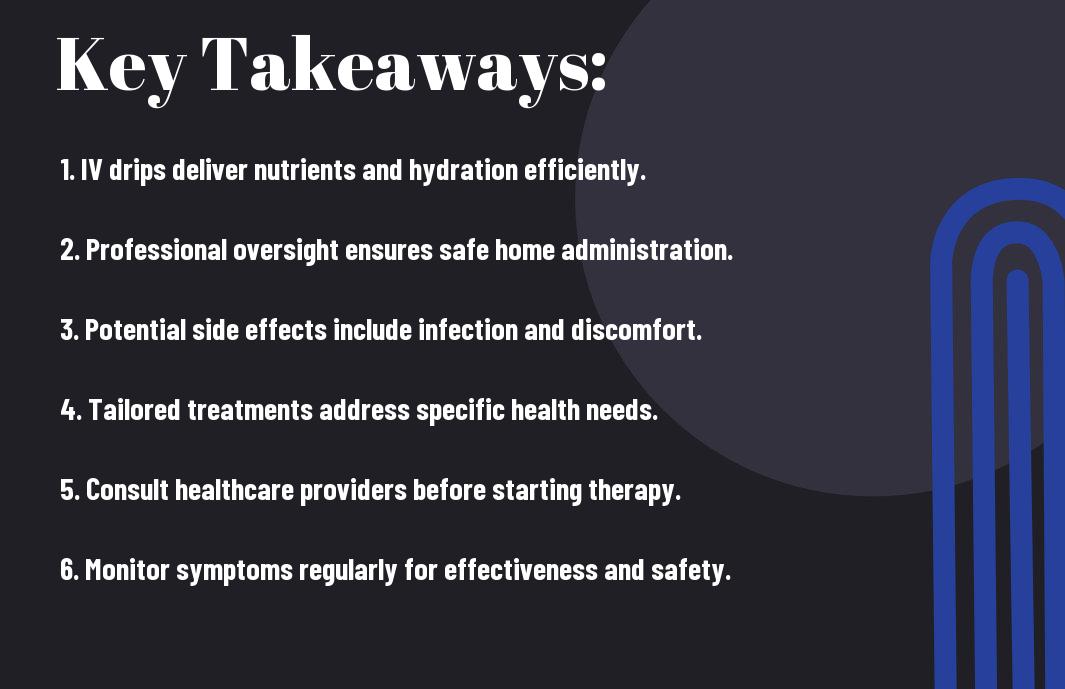It’s important for you to grasp the safety and effectiveness of IV drip treatments when considering them for home use. While these treatments offer potential benefits such as improved hydration and nutrient delivery, they also come with risks that require your attention. Understanding the proper administration techniques and hygiene practices can significantly impact your experience and outcomes. In this blog post, you’ll discover key insights into making informed decisions about home IV therapy, ensuring both your safety and efficacy of the treatments.
Key Takeaways:
- Convenience: IV drip treatments at home offer easy access to hydration and nutrients without needing frequent hospital visits.
- Personalization: Treatments can be tailored to individual health needs, enhancing effectiveness for specific conditions.
- Safety Measures: Proper protocols and trained professionals are crucial to minimize risks associated with at-home IV therapies.
- Medical Oversight: Regular consultation with healthcare providers ensures that IV treatments remain safe and appropriate.
- Potential Benefits: Users often report improvements in energy levels, recovery time, and overall wellness from at-home treatments.


What Are IV Drip Treatments?
While IV drip treatments are often associated with hospitals, they are increasingly being administered in home settings, offering convenience and comfort for patients. These treatments involve delivering fluids, vitamins, or medications directly into your bloodstream via an intravenous line, ensuring rapid absorption and efficacy for various health concerns.
Definition and Purpose
Before you explore the options available, it’s important to understand that IV drip treatments are designed to provide synchronous hydration, replenish nutrients, and administer medications effectively. By delivering important fluids and compounds directly into your bloodstream, these treatments can enhance your overall health and well-being.
Common Types of IV Drip Treatments
Purpose of these treatments varies, but generally, they can enhance hydration and boost your immune system. Below is a look at the most common types:
| Hydration Therapy | Replenishes fluids lost due to illness or dehydration. |
| Vitamin Infusions | Delivers important vitamins for increased energy and immunity. |
| Electrolyte Replacement | Restores balanced electrolytes in cases of dehydration or illness. |
| IV Medications | Administers important medications for various health conditions. |
| Glutathione Therapy | Enhances detoxification and skin health. |
In fact, each type of IV drip treatment serves its specific advantages, catering to different health requirements:
| Hydration Therapy | Essential for those who experience dehydration. |
| Vitamin Infusions | Perfect for combating fatigue and enhancing energy. |
| Electrolyte Replacement | Helpful after strenuous exercise or illness. |
| IV Medications | Quickly delivers necessary treatments for urgent health issues. |
| Glutathione Therapy | Benefits overall wellness and skin clarity. |
The safety and effectiveness of your chosen treatment can depend on various factors, including your overall health and specific needs. Always consult healthcare professionals to ensure that you receive the most appropriate treatment for your condition.
Benefits of At-Home IV Drip Treatments
Some of the primary advantages of at-home IV drip treatments include enhanced IV treatment at home: MedlinePlus Medical Encyclopedia access to hydration and necessary nutrients. These treatments can help improve overall wellness, boost energy levels, and support recovery from ailments in the familiar environment of your home. Additionally, this convenience may lead to a reduction in hospital visits, making healthcare more efficient and personalized for your unique health needs.
Convenience and Comfort
One of the most significant benefits of at-home IV drip treatments is the convenience and comfort that they offer. You can receive therapy without the hassle of traveling to a clinic or hospital. This not only saves time but also allows you to relax in your own space, surrounded by familiar comforts, which can contribute positively to your overall experience and enhance your recovery process.
Customization and Personalization
Customization is another notable benefit of at-home IV drip treatments. You can tailor the specific nutrients and fluids you receive according to your individual health requirements and personal preferences. This personalized approach ensures that you are receiving the most effective treatment designed specifically for your needs.
Consequently, at-home IV drip treatments enable you to address your unique health challenges more effectively. You can work closely with healthcare professionals to design a regimen that includes targeted vitamins, electrolytes, and hydration, which are especially beneficial for enhancing performance, recovery, and overall well-being. This level of personalization helps maximize the benefits of the treatment, allowing you to achieve better outcomes at your own pace and according to your schedule.
Risks and Safety Concerns
Many individuals considering IV drip treatments at home may overlook the potential risks involved. Administering intravenous therapy without proper training can lead to complications, including infection, improper dosage, or allergic reactions. Understanding these risks is vital for ensuring your safety and well-being during the treatment process.
Potential Side Effects
Concerns about potential side effects from IV drip treatments are valid and varied. You may experience mild reactions such as soreness at the injection site, or more severe effects like dizziness, nausea, or fever. It is important to stay vigilant and be aware of how your body responds during and after the procedure.
Importance of Professional Oversight
Before proceeding with at-home IV treatments, you should consider the necessity of professional oversight. Having a healthcare professional involved can help mitigate risks and ensure that the process is tailored to your specific needs. Their knowledge can provide you with the confidence that dosage and equipment are appropriate and sterile.
A healthcare professional plays a significant role in monitoring your vital signs and recognizing any adverse reactions that could arise during treatment. Their expertise ensures that any potential complications are addressed immediately, allowing for timely interventions. Additionally, they can guide you on the suitability of certain nutrients or medications within the drip, promoting safer and more effective outcomes. Engaging with a qualified provider not only improves your safety but enhances the overall effectiveness of the IV drip treatment you undergo.

Who Should Consider At-Home IV Drip Treatments?
Once again, at-home IV drip treatments can be an appealing option for individuals seeking convenience and tailored hydration solutions. These treatments may benefit those with busy lifestyles, chronic illnesses, or specific health needs that require regular vitamin or mineral supplementation. Understanding whether this method aligns with your health objectives is important before committing to the therapy.
Suitable Candidates
Treatments may be ideal for individuals suffering from fatigue, dehydration, or certain medical conditions that impair nutrient absorption. Additionally, athletes seeking recovery after intense workouts or those with specific vitamin deficiencies can find these treatments particularly advantageous. However, it’s important to assess your unique circumstances before proceeding.
Consultation with Healthcare Professionals
Above all, consulting with a healthcare professional prior to undergoing IV drip treatment is important. A licensed practitioner can help evaluate your current health status, identify potential risks, and recommend appropriate treatment protocols tailored to your needs. This step ensures you avoid adverse reactions and receive optimal benefits from the therapy.
A thorough consultation also allows your healthcare provider to assess any underlying health conditions, potential allergies, or medications that may interfere with the treatment. Discussing your treatment objectives openly will lead to a more personalized approach, ensuring that you achieve the best possible results from at-home IV drip therapy while minimizing the risk of complications.
Choosing a Provider for At-Home IV Drip Services
For those considering at-home IV drip treatments, selecting the right provider is imperative to ensure safety and efficacy. Look for a reputable company with trained professionals who can provide personalized care tailored to your specific health needs. This choice can significantly enhance your overall experience and health benefits.
Criteria for Selection
Against common misconceptions, not all at-home IV drip services are created equal. Prioritize finding a provider with licensed medical professionals and a solid reputation. Verify their experience in administering IV treatments, and ensure they follow strict hygiene protocols to minimize the risk of infection.
Questions to Ask
Among the many considerations when choosing a provider, it’s vital to ask the right questions to gauge their credibility and service quality. Start by inquiring about their credentials and experience in administering IV therapy. Ask about their protocols for emergency situations and what measures are taken to ensure safe, sanitary conditions during treatment. Additionally, be sure to understand how they tailor drips specifically to meet your unique health requirements.
And don’t hesitate to question the type of ingredients used in their IV solutions to ensure they align with your health objectives. Clarifying the delivery process and assessing the provider’s response time in urgent situations can help you feel more secure. A provider’s willingness to address your concerns transparently is a strong indicator of their commitment to your well-being.
Preparing for an At-Home IV Drip Treatment
Not everyone is suited for an at-home IV drip treatment. Before proceeding, consult with your healthcare provider to determine if it’s the right choice for your needs while ensuring they understand your current health conditions and medications.
Pre-Treatment Guidelines
With your healthcare provider’s approval, gather all necessary supplies, including sterile IV equipment and the vitamin or hydration solution. Make sure to clear a comfortable space for the treatment, ensuring it is well-lit and free from distractions.
What to Expect During the Treatment
For the duration of your IV drip treatment, you can expect to feel a range of sensations. Initially, you may feel a slight prick when the needle is inserted, but the discomfort is usually minimal. Once the IV is set up, the infusion will begin, and you should experience a gradual warming sensation as the fluid enters your bloodstream.
Preparing for the treatment involves understanding what will happen during the session. Expect relaxation as you sit comfortably, but also stay aware of any adverse reactions like swelling, redness, or pain at the injection site. It’s necessary to have a qualified professional monitoring your infusion to address any potential complications right away. Watching for signs of discomfort is important, as they could indicate an issue that requires immediate intervention. Overall, many people find the process invigorating and beneficial.
Conclusion
With this in mind, understanding the safety and effectiveness of IV drip treatments at home empowers you to make informed choices about your health. It’s important to consult with qualified healthcare professionals to ensure that these treatments meet your individual needs and that any potential risks are carefully managed. By doing so, you can maximize the benefits of at-home IV therapy while prioritizing your overall well-being.
FAQ
Q: What are IV drip treatments, and how do they work at home?
A: IV drip treatments involve administering fluids, vitamins, and medications directly into the bloodstream through an intravenous (IV) line. At home, trained healthcare professionals can set up the IV infrastructure, allowing for a comfortable and convenient treatment experience. This method ensures fast absorption and immediate effects, making it popular for hydration, vitamin supplementation, and certain medical therapies.
Q: Are at-home IV drip treatments safe, and what precautions should be taken?
A: At-home IV drip treatments can be safe when performed by a qualified healthcare provider. To ensure safety, providers should perform thorough assessments to determine eligibility for treatment. Equipment must be sterile, and the delivery should occur in a clean environment. Monitoring for any potential side effects or allergic reactions during and after the infusion is also necessary to address safety concerns.
Q: What conditions can be treated with at-home IV drip therapies?
A: At-home IV drip therapies may be used for various conditions, including dehydration, migraine relief, fatigue, nutritional deficiencies, and hangover recovery. Some patients may also use them for immune support or recovery after surgery. However, it is important to consult with a healthcare professional to ensure that the treatment aligns with individual health needs.
Q: How effective are at-home IV drip treatments compared to traditional methods?
A: At-home IV drip treatments can be highly effective due to the direct delivery of nutrients and medications into the bloodstream, bypassing digestive processes that can hinder absorption. However, efficacy can vary based on the individual’s health condition, specific treatment goals, and the formulation of the IV solution. Personalized treatment plans developed by healthcare providers can help maximize effectiveness.
Q: What are the potential side effects of at-home IV drip treatments?
A: While many individuals tolerate at-home IV drip treatments well, potential side effects can include localized pain or swelling at the injection site, allergic reactions to components of the infusion, or systemic reactions such as dizziness and nausea. It is vital to discuss any known allergies or medical conditions with the healthcare provider before treatment to minimize risks and receive appropriate monitoring.
